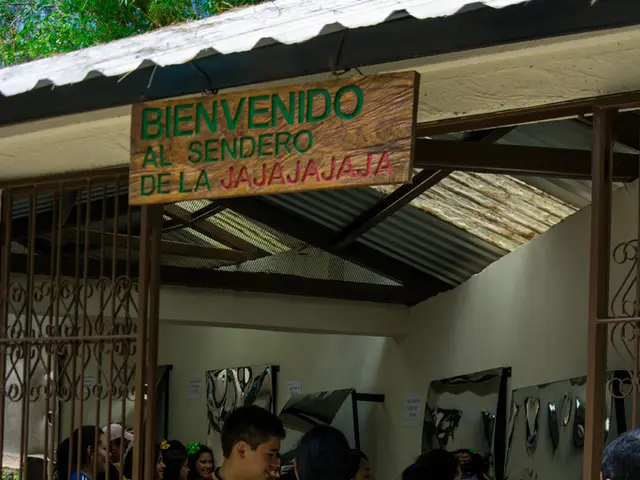A Tale of a Deepfake Scandal Rocking a Baltimore High School
High School Principal Falsely Accused of Racism by AI Voice Cloning, Baltimore Suspect Under Investigation
In an unfolding drama, the Baltimore County Police nabbed the former athletic director of Pikesville High School last Thursday, accused of using sophisticated tech to impersonate the school's principal and spread vile, hateful remarks, stirring public outrage, as per The Baltimore Banner.
Dazhon Darien, the culprit, was apprehended at a Baltimore airport in the morning, attempting to board a flight to Houston with a firearm, according to the report. Investigators later uncovered that Darien had manipulated the principal's voice using an AI cloning tool, creating a fake recording that circulated widely on social media, making disparaging comments about students of color and the Jewish community.
The police department released a statement confirming their investigation had yielded undeniable evidence the recording was a phony. They even hired a forensic analyst contracted by the FBI to analyze the recording, resulting in the discovery of traces of artificial intelligence content within it.
This apparently fabricated audio led to a wave of vitriolic messages directed at Principal Eric Eiswert and forced a temporary withdrawal from the school. The school's reception was inundated with phone calls from concerned parents. To restore a sense of security, the Pikesville school district arranged for a police presence at the school and Eiswert's residence.
Officials believe Darien orchestrated the deepfake as retaliation against the school principal. Reports suggest that a month prior to the outburst, Eiswert initiated an investigation into Darien for suspected embezzlement of school funds. Darien reportedly bypassed proper procedures by authorizing a payment of $1,916 to the school's JV basketball coach, who also happened to be his roommate, without proper authorization. Darien handed in his resignation earlier in April, as mentioned in school documents.
The Banner reported that Darien was the first in a series of teachers who received the audio clip the night before it went viral. Another teacher who received the recording allegedly forwarded it to students, media outlets, and the NAACP. According to charging documents, Darien used the school network to search for OpenAI tools and employ large language models on multiple occasions. However, it remains ambiguous how the investigators accurately pinned the creation of the voice recording on Darien.
Deepfakes, AI-generated audio deceptions, are causing a massive headache for the tech industry. The Federal Communications Commission took proactive steps in February to outlaw deepfake robocalls following a phony recording of Joe Biden duping New Hampshire voters.
In this particular case, AI experts were able to discern the supposed recording of the Baltimore principal was a sham. However, this revelation happened two months after the audio went viral, perhaps exacerbating the damage. It's evident that early detection of deepfakes is critical to minimize harm, but that's a challenge easier said than done.
Deep-Diving into Deepfakes: A Combination of Technology, Collaboration, and Ethics
Battling these AI-generated audio deepfakes demands a blend of technical know-how, collective actions, and ethical considerations. Here's an overview of the methods and measures employed:
Detecting Deepfakes
- Advanced Models: Speech foundation models and systems like SONAR are used to identify AI-generated audio. SONAR offers a comprehensive benchmark for assessing AI-audio detection techniques across multiple datasets.
- Machine Learning: AI systems analyze audio for indicators such as uncommon vocal patterns or inconsistencies in speech tempo.
- Multi-Layered Detection: Combining different detection methods, such as behavioral analytics and automated scanning, bolsters robustness against highly advanced deepfakes.
Preventive Measures
- Collaboration: Industry players and governments are collaborating to create comprehensive databases for deepfake recognition, enhancing detection precision.
- Education and Awareness: Public campaigns instruct individuals on recognizing and flagging potential deepfakes, decreasing misinformation risks.
Regulatory Frameworks
- Legal and Ethical Standards: Governments are strengthening regulations around synthetic media development, demanding more responsibility and transparency.
- Blockchain Technology: Blockchain technology is utilized to verify content authenticity by preserving decentralized records of media origins, protecting against tampering.
Confronting Viral Deepfakes
- Speed and Responsiveness: Rapid detection systems are being developed to address the challenge of real-time deepfake detection.
- Cross-Platform Collaboration: Social media platforms and media outlets are cooperating to eliminate false information swiftly and disprove them before they spread widely, including implementing AI-powered moderation tools.
- Public Engagement: Encouraging public awareness of deepfakes helps to minimize their impact by reducing the number of people who might believe and share them.
In a nutshell, combatting AI-generated audio deepfakes necessitates both technological advancements in detection and broader societal efforts, including education and regulatory reforms, to prevent and mitigate their impact.
- The Baltimore County Police's investigation into the deepfake scandal at Pikesville High School revealed traces of artificial intelligence content within an allegedly fabricated audio recording, highlighting the importance of AI cloning tools in technology.
- The deepfake audio scandal that rocked Pikesville High School bore resemblance to the phony recording of Joe Biden, as the Federal Communications Commission took proactive steps to outlaw deepfake robocalls in February.
- To combat AI-generated audio deepfakes, it's crucial to employ advanced models like SONAR for identification, utilize machine learning to analyze audio for indicators, and combine different detection methods for robustness.
- In response to the growing problem of deepfakes, regulatory reforms are being implemented to demand more responsibility and transparency in synthetic media development, while blockchain technology is being utilized to verify content authenticity.




